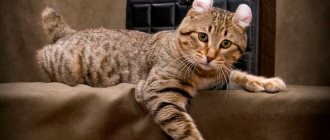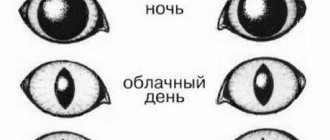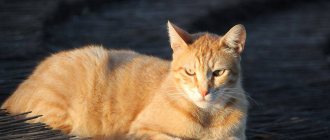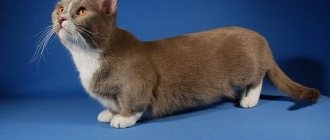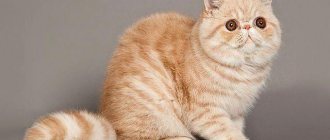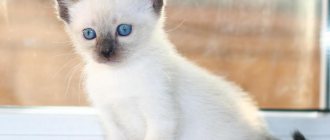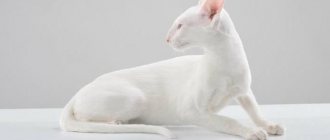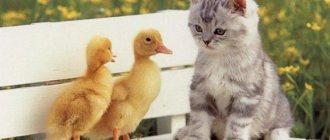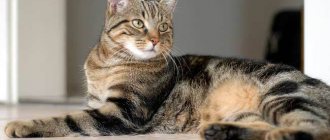Characteristics of British kittens
Breeders select healthy individuals without genetic or other abnormalities, with a stable psyche and a friendly attitude towards people.
By purchasing an animal without documents, you risk purchasing a pet with diseases of various origins, weak immunity, or encountering unpredictable behavior. Because a breed is not only a name and appearance, but also a character.
British cats need constant attention, which is important for people who are outside the house all day. With a self-sufficient and independent character, British cats are not aggressive in critical situations and are not prone to attacking people.
From birth, the British are clean and almost immediately get used to the tray and scratching post.
As for the appearance of the British, they are easily recognizable among others. British cats are classic representatives of the semi-cobby type. This body type includes the following characteristics:
- strong and short wide-boned body;
- short rounded paws:
- powerful short neck;
- a large round head with cheeks that resemble jowls;
- erect ears with soft rounded tips;
- Their nose (British cats), wide from the bridge of the nose to the tip, has a depression;
- large round eyes;
- short tail with thickening at the base and rounding at the end.
Thus, the British is a collection of soft, rounded shapes. All physical parameters are strictly regulated, so deviations from them are considered a violation of the standards and result in the cat being rejected.
But in addition to their special memorable appearance, these cats have good hereditary characteristics. With proper care, they have virtually no health problems, and their life expectancy ranges from 12 to 20 years.
It is widely believed that a British cat can be distinguished from its relatives of another species by its eye color. This is not an exact sign, since a kitten’s eye color can only be fully determined by the first year of life.
In addition, eye color is tied to coat color and this must be taken into account when choosing a pet, as well as the fact that the presence or absence of certain traits is genetic.
Genes are divided into dominant and recessive, which means that no matter how beautiful blue eyes look, they are rare among British cats. After all, the gene for blue eyes is recessive, that is, it is suppressed by others.
Persian cats breed description
Distinctive characteristics of the breed, recognizable features.
- A small snub nose, the shape of which in the extreme American type of breed looks small and strongly turned up. The European classic Persian has the usual slightly upturned nose.
- Fluffy, soft and silky long coat, reaching up to 15 cm with a variety of colors.
A complete description of the breed is provided in the summary table.
Table No. 1 Description of the Persian cat breed:
| Breed: Persian cat, origin: Iran (Persia), year of first registration: 1887 in Europe | ||
| External data | Description | Note |
| Body, body, chest. | The build is medium to large, stocky with a muscular, fairly broad chest. | Straight short bone looks squat but compact |
| Paws, limbs. | The legs are short, but muscular and powerful. The panties are clearly marked on the hind legs. A tuft of fur grows between the toes of the rounded paws. | Long hair hides the already short length of the limbs. |
| Tail. | Proportional length in comparison with the body, does not appear short due to long hair. | A sharp tail tip with knots along its length is considered a defect. considered to be a knobby tail |
| Head, muzzle, neck | On a thick, short neck, a large head with a wide forehead merges with the body. The muzzle has a round shape, on which a strong chin is clearly marked. | The neck is surrounded by a collar with a longer neck. A luxurious collar is a must. |
| Eyes, iris color. | Widely spaced, large, round eyes have a color that matches a specific coat. | For chinchillas – green; for color points - blue; for white, especially valuable ones - blue or multi-colored, one is light blue, and the second is orange. For all other colors, copper or orange tones are acceptable. |
| Ears | Set low above the forehead, the small, rounded ears are set wide apart. | There are tufts of fur inside the ears. |
| Wool | The long, up to 15 cm, thick coat is soft and silky to the touch. The thick undercoat lies close to the body. | Persian kittens can be solid, point or tabby in color. |
| Average height at withers in males and female cats | 28-30 cm | Due to long hair, the average height visually decreases, and weight, on the contrary, increases. |
| Average weight of Persians | from 3.5 to 7 kg | |
| Average life expectancy | Can range from 12 to 14 years, | With good care and health, the breed can live for up to 20 years. |
Persian cats and cats photos
Longhair
The body of the Persian cat of the classic and extreme type is covered with soft, silky hairs that hide a thick undercoat. The length of the fur in different parts of the body is distributed unevenly throughout the cat’s body and can range from 10-20 cm. A fluffy collar around the neck with a length of up to 20 cm. The panties on the hind legs and the tail have more enlarged hair.
Shorthair
The exotic shorthair cat is a half-Persian cat that is the result of the mating of an American shorthair cat and a Persian cat. As a result of selection, a new type of Persian was developed with a muzzle similar to a Pekingese, rounded, decorated with small ears and with a body covered with short hair.
Video
Types of Persian cats and their colors
Breeders from many countries have achieved that the Persian cat can have varieties with any coat color. The main classic types of Persian cat colors are still the most popular, these include:
- Solid, solid colors: white, blue, red, black, in which the coat is evenly colored without inclusions or spots of a different color.
- Bicolor colors, similar to the Siamese.
- The tortoiseshell color is characteristic mainly of females.
Black
The black Persian cat is covered with fine and silky fur without bleached spots or white speckles, especially long on the shoulders and around the neck. The American exclusive type Black Persian has the same charcoal paw pads, while the classic European type may have black or brown paw pads.
Blue
The longhaired Blue Persian is a very popular color all over the world. The fine, silky hair is evenly distributed over the dense undercoat, except for a longer collar on the neck. With a blue tint to the eyelids, a short flattened nose and gray-blue paw pads. Round, large eyes, orange or copper-tinged. Kittens are born with the presence of a tabby pattern, which gradually levels out to a blue color.
Tortoiseshell
A Persian tortoiseshell cat whose coat spots are evenly distributed over the body, and a red or cream tint is preferred on the face. There are several combinations of spots in color.
In the exclusive type of Persian, white predominates, especially on the belly, while in the classic type, white color and other tortoiseshell spots are evenly distributed.
Tortoiseshell males are born rarely and sterile.
White
The white Persian was the result of crossing with a white Angora cat, a very valuable color. A white cat with blue or multi-colored eyes is a beautiful animal, but often has a genetic disease; they have difficulty hearing or become completely deaf.
The fur should be pure white, silky evenly distributed over the body, and the snub nose should be pink, as should the paw pads.
Ginger
Persians with very long, silky hair of a thick red, pure red color are quite rare. They usually have brick-red colored paw pads, eye rims and nose. The eyes are round, large, orange or copper in color. The red tail is very fluffy.
Grey
The gray color of the Persian is solid solid with evenly colored hair from root to tip with the absence of white hairs and other marks. The color of the paw pads and nose mirror looks like the main color of the coat, and the large eyes are copper and less often green.
Color point
Color-point Persians have a cream or ivory-colored coat with non-blurred, clear spots, like Siamese. Large, round eyes of a dark blue color, almost blue.
Differences in coat quality and color
There are two types of British cats: British Shorthair and British Longhair.
The classic color is blue (gray). Moreover, the color of the coat and undercoat must match.
Because of this feature, British cats are often confused with Russian blue cats. However, after carefully studying the standards of both breeds, it becomes clear that these are different animals.
Meanwhile, breeders are working to create new color options for cats without losing other standards of the species. Today there are already white, red and black colors, as well as many shades, for example, British reds are divided into red (bright red) and cream (peach).
Rare color options
Breeders of the breed recognize the British color-point colors as the rarest, as well as two-color, tri-color and smoky.
Material on the topic: what is the British cat breed.
Two-color and three-color
White is acceptable in these color combinations. The earliest tortie and white tricolors were bred; the original version had black, red and white, but now any two colors are allowed in combination with white. Two-color cats saw the world a little later; their coat has spots of the same color on a white background. In the video below you can see the different colors and character traits of the British.
Color point
These cats originated almost four decades ago when breeders crossed Himalayan cats with British Shorthairs. This gave the breed a blue-eyed version of the British with a light coat that features contrasting mask-like markings on the face and darker coats on the ears, tail and paws. The transition of colors should be clearly defined and have a good contrast with the body. The breed standard also allows tortoiseshell-colored “glasses.”
Color Point can have light fawn, lilac or blue markings. If they are blue, then the pedigree will say: blue point. The muzzle should have a white marking in the shape of an inverted V. The top of the V should start at the forehead and widen to cover the nose and whisker pads. Markings should be as symmetrical as possible. There should be a good, clear contrast between the body color and the spots. The chest, chest and belly should be white; The cat's four paws should be white.
Material on the topic: everything about the British cat and caring for it.
Smoky
The smoky variety is characterized by a silver-colored undercoat, which is visible through the top layer of fur, especially when the cat moves, thereby creating a hazy effect. The top layer can be brown, tortoiseshell, or black.
At what age will the difference be clearly visible?
The characteristic appearance of the British breed distinguishes them from representatives of other breeds even at a very young age. However, only an adult, mature individual can be checked for compliance with the standards. Then we can say whether it is a purebred cat or a crossbreed.
Depending on the breed, the age at which a cat is considered an adult also varies. Bengal cats take 9 months to fully mature, Maine Coons take 2 years.
The British breed is considered mature at 12 months of age. Around this time, all processes associated with changes in coat and eye color are completed.
Is it possible to identify a Briton by his behavior?
There are also standards for the behavioral characteristics of a cat. The British are calm and clean pets, aristocrats from the cat world, so many people choose this breed due to its character.
These animals are not prone to hooliganism and find peaceful activities in the absence of their owners, for example, playing with specially designated objects or sleeping. They are easy to train to the litter tray and scratching post.
When you meet, don’t be shy about asking for documents and pedigree of the animals. Thanks to it, you will be able to understand what adult cats and cats from this litter will be like, because their external signs of kittens can change with age.
In a specialized club or nursery, future owners will be given a confirmation that the kitten belongs to their breed, a conclusion about its state of health and a certified birth certificate or a pedigree compiled on the basis of the metric, which will detail information about the ancestors up to the fourth generation. This is not cheap, nor is purchasing a purebred animal.
If it so happens that your pet is not a completely purebred representative of the breed, the swindlers can be held accountable by contacting law enforcement agencies and receive compensation in accordance with the procedure established by the court.
And the kitten you adopted is a living creature that loves you. He is already a new member of the family, a devoted friend and companion. Be responsible and merciful, do not abandon those you have tamed.
Basic moments
- This breed has been around the British for so long that in its homeland it is simply called shorthair.
- Recognizable features are a round muzzle, a stocky body and thick fur of a special texture, tactilely reminiscent of plush.
- Long before the appearance of the first “cat” organizations, the British Shorthair cat was valued not for its external qualities, but for its unsurpassed skill as a mouser.
- Animals openly show their affection for their owners, but do not like to sit on a person’s lap or hang in a person’s arms.
- They get along well with other pets (including dogs, rodents and birds), but do well as an only pet.
- Cats do not require complex and specific care.
- After reaching adulthood, the level of physical activity decreases significantly.
- Veterinarians call obesity the main danger facing British apartment dwellers.
- British Shorthairs are generally considered to be healthy cats, with an average lifespan of 12-17 years.
The British Shorthair cat is one of the breeds that nature has worked on much longer than humans. As a result, we have a physically developed, harmoniously built animal with a light, easy-going character. Living together with him will not cause the owners much trouble. British cats are attractive due to their calm disposition, bordering on phlegmaticity, good manners and incredibly beautiful, pleasant to the touch plush fur. In the famous book “Alice in Wonderland” Lewis Carroll forever immortalized this breed in the image of the Cheshire cat.
Content Features
Despite their natural health, Britons require proper care.
To extend your cat's life, choose the right food. Ideally, you should visit a veterinarian who will create a healthy diet. Take your pet to the veterinarian regularly: the cat will not complain if it gets sick.
Below are the best foods for British Shorthair cats:
White color is found in many cat breeds. But there are varieties for which this color is the only acceptable felinological standard, for example, Kao-mani or Forinwhite.
Be sure to read the article to the end, there is a lot of interesting stuff there.
History of the British Shorthair cat
Over the years, it is impossible to find documentary evidence of the first appearance of cats in the British Isles. However, researchers suggest that domesticated animals were brought there by Roman conquerors. The legionnaires, of course, did not keep them as furry friends - someone needed to protect the provisions in the holds from the attacks of ship rats. True, those rodent hunters bore little resemblance to today’s round-faced and well-built individuals; their physique was closer to the graceful and long-legged Egyptian animals.
But the free feline nature took its toll - and some of the small predators brought by the invaders moved from the decks to solid ground, and there, over time, they met wild relatives who enriched the gene pool.
For centuries, short-haired purrs lived side by side with peasants, receiving a little milk and a roof over their heads for their contribution to the fight against mice. No one, of course, cared about selecting kittens based on coat color, ear shape and tail length, so the appearance of the breed was formed naturally. It must be said that the attitude towards these cute creatures was often not just indifferent, but even hostile, while dogs were considered true friends, worthy of sugar bones and a place by the fireplace.
It was only in the second half of the 19th century that the British realized that their pets had many unique and attractive characteristics that needed to be strengthened and developed. In the Victorian era, being the owner of a cat became not shameful even for a representative of high society. The popularity of mustachios was greatly promoted by the original and witty drawings of the famous English artist Louis Wain. A talented graphic artist created a whole universe in which anthropomorphic cats play golf and bridge, go on picnics, read newspapers, have Christmas parties, sledding, play music, relax on the beach... In addition, already at the dawn of the development of photography, enthusiasts of the new art realized that how beautiful furry creatures look in the frame. In a word, the ice was broken.
On July 13, 1871, the world's first professionally organized cat show was held in London with great success. Harrison Ware, with the support of the then manager of Crystal Palace, invited 170 event participants and their owners to the former World's Fair pavilion. He also developed competition regulations, a system for awarding points and determining winners in various categories. Visitors were surprised to discover that well-groomed and well-fed cats not only look charming, but also behave like real aristocrats. The next morning, the front pages of the capital's respected newspapers were adorned with portraits of the award winners, including 14-year-old blue tabby Old Lady. By the way, it was the blue color that was considered the only correct color for British shorthairs in the last century.
After the exhibition, the once unnoticed street animals gained popularity. A breed standard, amateur clubs and the first kennels appeared. However, in the last decade of the 19th century, Great Britain was overwhelmed by the pan-European fashion for Persian cats. On this wave, during the First World War, breeders introduced the British Longhair. Experts still cannot say with certainty whether a fixed spontaneous mutation took place or whether the breeders simply used “foreign” genes in breeding.
With the outbreak of World War II, the already unfavorable situation for shorthairs became truly catastrophic. Animals, like people, died en masse under German bombing, and the policy of food austerity left no chance of maintaining nurseries. In the post-war years, the few surviving British cats were actively crossed with representatives of various breeds to produce offspring: Russian Blue, Chartreux, Persian. Due to the large percentage of mixed blood, the breed was classified as a hybrid for a long time and therefore was not registered by leading regional and world felinological organizations. The American Cat Association distinguished American Shorthairs from Old World cats in 1967, listing the latter under the name "British Blue." The ACFA accepted the breed in 1970, and The Cat Fanciers' Association (CFA) recognized the breed in 1980.
Story
The first mentions of this breed are found in ancient chronicles. There is no documented information about their origin. The first very large rat-catching cats were brought in by Roman centurions. Researchers suggest that cats were introduced by the Romans during an attack on the British Isles in 43 AD. e. In Britain they were called the “British cat”, in France - “Charteuse”, in Germany - “Carthusian cat”.
The animals were used as rodent hunters, but by the end of the 16th century, breeders paid attention to the appearance of cats. The British attended the first London cat show in 1871. Then official breed standards were adopted, and felinology began its rapid development.
The first British appeared in Russia in 1992, along with the Cartheusers, who are now called in Russia “the old type of British.”
To consolidate the unique features of the British, breeders used Persian cats - which is why British cats have a slightly flat face.
The British Fold cat is an extraordinary beauty
Greetings, dear readers! Despite the fact that professional breeders claim that officially there is no such breed as the British Fold cat, backing up these statements with facts, in the international system there are 2 varieties of British cats: shorthaired and longhaired.
Only Scottish cats have fold ears.
It is not customary for breeders to cross breeds with each other, but people have the right to cross a British cat with a Scottish cat and get a British Fold.
Types of cat colors
Each color is determined by a combination of genes responsible for the distribution of melanin in the hair. Felinologists distinguish several varieties of cat colors:
- white with complete or partial absence of pigmentation;
- tabby (tabby), which is considered the most ancient;
- solid – solid;
- color point;
- tortoiseshell or tricolor;
- tipped;
- unrecognized shades such as cinnamon, fawn or apricot.
The table below shows the most common colors:
| Code | Color | The breed that appeared for the first time |
| a | blue | Ancestors of Russian blue cats, approximately 15th century. |
| b | chocolate, brown | Appeared around 1000 l. BC e. |
| c | lilac, platinum | The gene was originally present only in Oriental breeds. |
| d | ginger | The gene mutated during the domestication of cats. |
| e | cream | There is no reliable data. |
| f, g, h, j | tortoiseshell | The mutation that caused the tortoiseshell color first appeared in cats living in Turkey - Persian, Van, and Angora. |
| n | black | One of the most ancient colors, appeared during the time of Phenicia. |
| s | smoky | Norwegian forest cats. |
| w | white | Cats of Ancient Egypt and Thailand. |
White (no pigmentation)
It’s not for nothing that snow-white cats with bright blue eyes are considered real beauties. Many people, when choosing a kitten, try to take an animal of exactly this color. Most often, white cats are found among representatives of the Persian, Angora, British Shorthair, and Balinese breeds.
The white color of the fur and the blue color of the eyes are due to the absence of the coloring pigment melanin. The white gene W dominates the genes of other colors and completely suppresses them. When mating two snow-white pets, multi-colored kittens can be born. This suggests that both parents were heterozygous.
Such beauty has its side effects: many white cats are born deaf. The W gene is responsible for the migration of melanoblasts from the neural tube of the embryo to the skin and retina of the eyes. During the process of domestication, the gene mutated, due to which melanoblasts do not have time to reach the hair and iris during the embryonic development of the cat - the fur remains white and the eyes remain blue. At the same time, other cells of the neural tube stop moving, and the inner ear degenerates.
Another reason for white coloring is albinism. Albino cats are born with the participation of the recessive genes ca (blue iris) or c (red iris).
Tabby (tabby), or wild: mackerel, marbled, spotted, ticked
A striped, spotted, “tiger” pattern on the coat is a tabby color. The T gene is responsible for spotting, and it is present in all cats without exception. This is the genetic heritage of ancient wild cats, which had just such a protective, camouflage color.
Why aren't all cats tabby? In order for a tabby pattern to appear on the fur, the dominant allele of the agouti gene A must be present in the animal’s genotype. Agouti promotes partial coloration of the hairs, which is why cats have this color: stripes, rings, spirals, spots.
Mackerel color
There are several varieties of tabby coloring with the agouti gene:
- mackerel - a pattern in the form of parallel vertical stripes, the so-called tiger;
- marbled - cats with this color have spiral stripes on the sides, 3 horizontal stripes on the back, the tail and paws are ring-shaped, and there are spots on the stomach;
- spotted – small spots or short stripes scattered across the body;
- ticked, or agouti tabby - there are no characteristic stripes and spots on the animal’s body, only the face is colored this way.
Solid colors (solid)
As already mentioned, the pigment melanin, which comes in two types, is responsible for the cat’s color. Consequently, the two main colors are black and red, the intensity of which depends on the dominance or recessivity of certain genes.
A solid coat color is called solid. How are the different solid cat colors formed? Black color appears as a result of the presence of the dominant gene B, its recessive manifestation b gives a brownish tint, and the bl variation further lightens the coat. Thus, the BB cat will be completely black, the bb cat will be chocolate, and the blbl cat will be a sorrel cat.
Color point color
If the genes responsible for fur coloring are only partially blocked, then cats with color point color, which is a form of albinism, are born. That is why such animals have blue or blue eyes. This color belongs to the group of acromelanistic colors, which depend on the body temperature of the animal. In areas with lower temperatures, the hairs are colored in a darker shade - on the face, ears, and tail. The body is predominantly light.
A striking representative of color-point breeds are Siamese cats. Point colors can be very diverse:
- seal – dark gray, almost black;
- blue - blue;
- red – red;
- chocolate – brown;
- cream – cream, beige;
- torti – tri-color tortoiseshell;
- tabby – spotted, striped;
- lilac – pink (gray-pink).
Tortoiseshell colors
Despite the fact that the cat's genome was completely deciphered in 2010, scientists still do not know for sure why the tortoiseshell (tri-color) color appears. The simultaneous presence of black and red spots is due to the activity of the Orange gene; one allele blocks the synthesis of eumelanin, and the other does not. Due to the fact that color is linked to sex, cats are not born tortoiseshell, only in the case of a genetic pathology - aneuploidy.
The classic tortoiseshell color is chaotic white, red and black spots. However, there are combinations of blue and cream, chocolate and red, lilac and cream. The following breeds of cats are tricolor: Maine Coon, Manx, Neva Masquerade, Turkish Van, Persian, Exotic, Bobtail, British Shorthair.
Tipped (silver, gold, shaded, smoky)
Tipped colors are caused by the influence of the dominant silver gene I, which is a melatonin inhibitor. It suppresses the production of coloring pigment, which is why the hair is only partially colored, the rest of it is white. There are several main options for this color:
Chinchilla cat
- smoky - the hair is white only at the very root, the rest is colored with the main color;
- silver – almost half of the hair is white;
- shaded - only a third is colored; when moving, silvery or golden tints form on the fur;
- chinchilla and cameo - only the ends of the hair are colored, chinchilla's are black, and cameo's are red.
Unrecognized (cinnamon, fawn, apricot)
All colors have their own code and are classified by felinologists from the International Cat Federation. Breeds have standards that indicate acceptable variations in coat, skin, and eye colors. Deviation from the standard is considered a defect; such animals are disqualified and do not participate in breeding.
Some colors have appeared recently. They were obtained through the efforts of breeders and are still so rare that their names are not included in international standards. In the photo below you can see rare colors.
These unusual and beautiful colors include:
The variety of cat colors is amazing. In addition, breeders do not stop there, and new colors may appear, which over time may become part of the breed standards.
What colors can a British Fold cat have?
If you look closely at the photos of these pets, you can conclude that blue is the most popular color among them. You can also find red, chocolate, grey, black, brown and even lilac Britons. A white or peach-colored British cat is quite rare to find.
Next is a photo of a brown British cat, which shows that the pet’s fur is quite smooth and short, resembling velvet in appearance.
Description of the character of British Fold cats
Many people, before letting a pet into their home and family, try to learn as much as possible about the description of the breed and the character of the future household member. This is a very wise decision, since many cat breeds are characterized by excessive independence, lack of attachment to their owners, and are not affectionate or friendly.
All of the above has nothing to do with British kittens; they are very affectionate and friendly, they love to be stroked and “squeezed”. The British are ideal for those families with small children, they get along well with them, take part in their games with pleasure, and do not offend them, provided that they are treated the same way.
Little kittens are easy to train, they grow quickly and learn from their mother cat how to groom themselves and go to the litter box. Even those kids who grow up without a mother quickly get used to doing their chores where they should be, without burdening their owners with cleaning up after them.
But, like most cats, the British are also characterized by pride and stubbornness; if the pet does not want to sit on your lap at the moment, you cannot restrain it. These pets rarely meow, hinting to their owners that they should be fed; they would rather sit near an empty cup, pretending that their owner is very irresponsible.
The nature of these pets is such that if you love them and show them due respect, they will repay their owners in kind. Check them out in this video:
How to care for a British Fold cat
Many future owners of this pet have questions about the care and maintenance of these cats. Buying a pet of this breed will be very successful for its future owners, since kittens from infancy begin to take care of themselves on their own, this applies to going to the toilet, cleaning their paws and other parts of the body with the help of a tongue. But, of course, there are also places that are difficult for the kitten to clean on his own, then the owner should help him.
Basic care for this breed is as follows:
- Cleaning your pet's ears of wax a couple of times a month will be enough.
- If the cat does not grind her claws down on a special scratching post, then you need to carefully trim them once a month, you can do this at the veterinary clinic.
- Your pet needs to wash its eyes once a week with a damp cloth or cotton pad soaked in warm water.
Also, the British need to be brushed regularly so that their coat does not become matted, is shiny and well-groomed. There is no need to wash your domestic cat often, just a couple of times a year is enough; for this you need to purchase a special shampoo at the veterinary pharmacy; under no circumstances should you wash your pet with ordinary gels and other products intended for people.
What to feed the British
Also, many questions arise about the care and feeding of British fold cats and cats. It should be understood that the beautiful appearance and health of a pet directly depends on what it eats.
The British can be fed in two ways, that is, either give them natural food or ready-made balanced food. It is very important not to mix these two methods of feeding your pet, otherwise you can create problems with the gastrointestinal tract.
If time and finances allow you to feed your cat natural food, then its diet should include the following products:
- Boiled meat (lamb, beef, chicken). Turkey can be fed raw. Fatty meats (pork, goose, duck) are prohibited.
- Vegetables, cereals.
- Cottage cheese, milk, cheese, yogurt, fermented baked milk or kefir.
Also, in addition to these products, kittens and adult cats need vitamin complexes specially developed for them, which can be purchased at veterinary pharmacies; they must be given in accordance with the attached instructions.
If there is not much time to prepare food for your pet, then it is better to organize his table using ready-made food. Only high-quality food is suitable for feeding this breed, ranging from premium class and higher; cheap brands of food are not absorbed by the pet’s body and can cause significant harm to its health. Also, the British should have constant access to clean water, preferably bottled.
Health features of British fold cats and cats
Before asking the breeder about the price of a pet, future pet owners should have an idea about the characteristics of its health and know its more vulnerable areas.
Due to the fact that the breed is artificial and cats of different breeds are crossed, very often problems arise with the formation of bones in kittens. The spine and fingers are especially at risk, as large, inert growths can grow on them, preventing the cat from walking.
This problem can only be solved surgically. To reduce the risk of its occurrence, it is better to organize the process of mating Scottish and British breeds under the supervision of an experienced breeder and veterinarian.
In addition, these pets may suffer from the following genetic diseases:
- Worm infestation.
- Obesity. British cats are prone to obesity, so you should monitor your pet's activity and not overfeed it.
- Hypertrophic cardiomyopathy. The disease develops after the pet reaches the age of 1 year, so during this period it is very important to give him an ultrasound.
Color and deafness
Many white cats are deaf due to inner ear degeneration. Geneticists studying these animals have determined that their deafness depends on eye color:
- 17-22% with eyes of any color except blue;
- about 40% are heterochromic (i.e. with different colors);
- 65-85% with blue eyes.
In cats with different eyes, hearing loss is usually observed on the side of the blue eye.
Kao-mani with blue eyes
The cause of deafness is in the dominant W gene. After much research, scientists have determined that it is pleiotropic - it is responsible for a number of traits in the genotype - not only for coat color, but also for deafness and blue-eyedness. By the way, you can also read about blue-eyed cats and breeds on our portal.
The dominant W allele disrupts the migration of melanoblasts—pigment producers and transporters—and also affects the activity of other cells in the area of the neural tube of the embryo
Deaf cats are excluded from the breeding program. And as a pet, they can live as absolutely full-fledged individuals; the lack of hearing is compensated by other senses. True, such animals will not survive on the street.
Cost of British visloushek
Fold cats are not purebred British, so you can get a cute kitten at a very reasonable price. Photos and prices of pets can be found from people who breed such kittens.
A British Fold kitten can be obtained at a price ranging from 2,000 rubles to 5,000-6,000, but in this case, most likely there will be no documents for it, including a vaccination card. You can even get such a kitten for free on the market or through free advertisements.
A cat that has documents and vaccinations may cost more, the price for them reaches 14,000-15,000 rubles.
